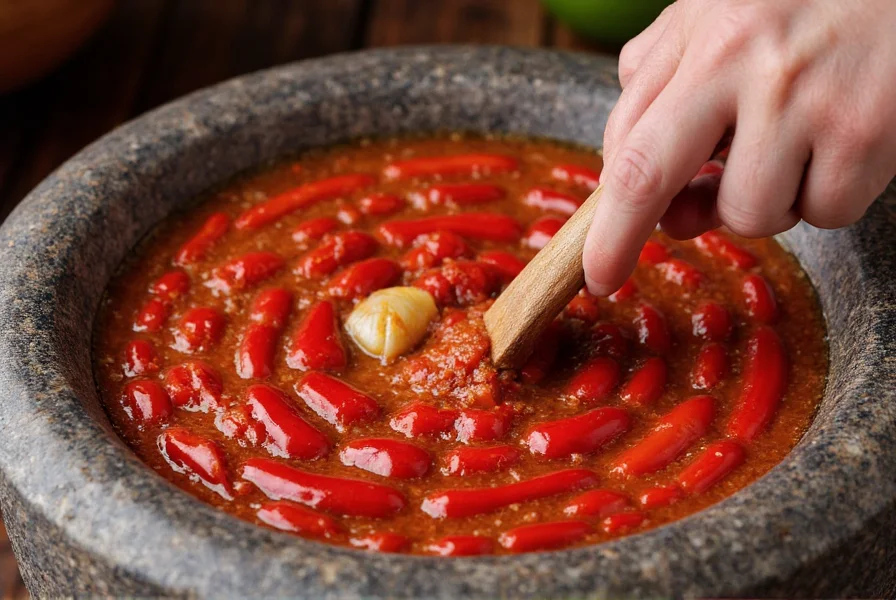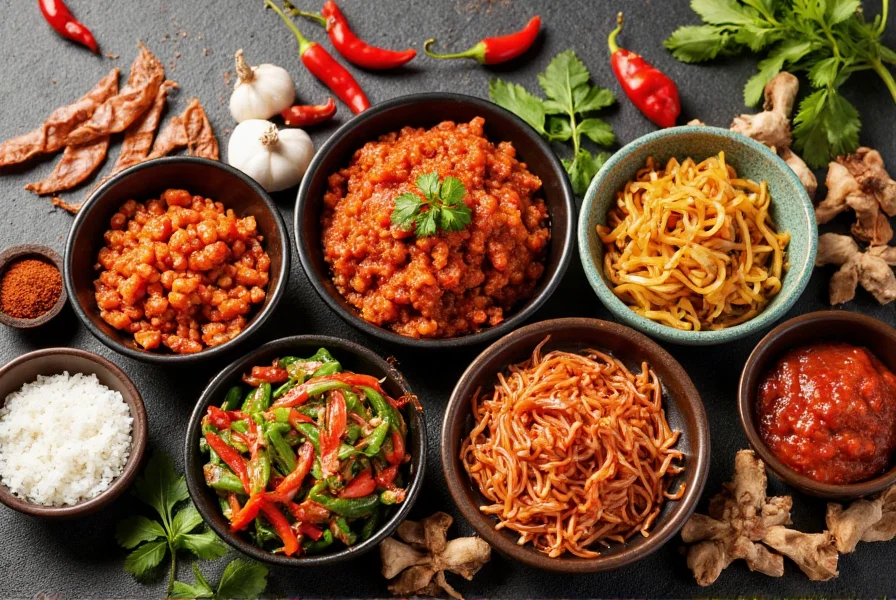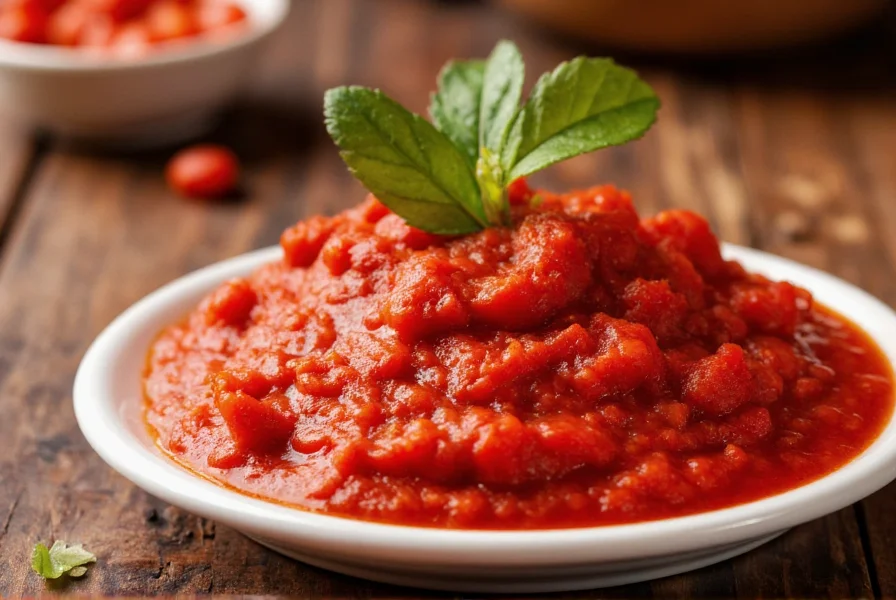Sambal chili paste represents one of Southeast Asia's most essential culinary foundations, with Indonesia claiming over 300 regional variations. Unlike Western hot sauces that often prioritize vinegar and sugar, authentic sambal maintains a fresh, complex flavor profile achieved through careful ingredient selection and preparation techniques passed down through generations.
Understanding Sambal: More Than Just Heat
While many Western consumers equate sambal solely with heat, this Indonesian staple offers nuanced flavor dimensions that balance spiciness with umami, sweetness, and aromatic complexity. The foundation of traditional sambal chili paste typically includes:
- Fresh red or bird's eye chilies (varying by regional preference)
- Shallots or red onions
- Garlic
- Terasi (fermented shrimp paste) - key for authentic umami
- Lime juice or calamansi for brightness
- Palm sugar for subtle sweetness
The preparation method significantly impacts the final product. Traditional sambal uses a cobek (stone mortar) and ulekan (pestle) to create a coarse texture that preserves fresh chili flavor, while commercial versions often use blenders resulting in a smoother, sometimes less vibrant product.

Regional Variations Across Southeast Asia
Sambal's diversity reflects Indonesia's archipelago geography and cultural variations. Understanding these differences helps appreciate authentic sambal chili paste beyond generic supermarket versions:
| Variation | Region | Key Characteristics | Heat Level (Scoville) |
|---|---|---|---|
| Sambal Oelek | Java | Simple chili, salt, vinegar; no shrimp paste | 10,000-25,000 |
| Sambal Terasi | Nationwide | Includes fermented shrimp paste for umami depth | 15,000-30,000 |
| Sambal Matah | Bali | Raw shallots, lemongrass, kaffir lime; uncooked | 5,000-15,000 |
| Sambal Dabu-Dabu | North Sulawesi | Fresh tomato, shallot, raw chili; salsa-like texture | 8,000-20,000 |
Sambal vs. Other Popular Chili Sauces
Many consumers confuse sambal chili paste with other Asian hot sauces, but key differences exist:
Sambal vs. Sriracha: While both originate in Southeast Asia, sriracha (from Thailand) contains significant vinegar and sugar, creating a sweeter, tangier profile. Sambal maintains fresher chili flavor with less acidity and often includes shrimp paste for umami depth. Authentic sambal oelek vs sambal chili paste differs primarily in complexity - oelek is simpler while traditional sambal includes multiple aromatics.
Sambal vs. Gochujang: Korea's gochujang features fermented soybean paste and glutinous rice, resulting in thicker texture and pronounced sweetness. Sambal relies on fresh chilies without the fermented bean component, offering brighter heat and more immediate chili flavor.
Sambal vs. Harissa: North Africa's harissa typically includes roasted red peppers and spices like cumin, creating earthier notes. Sambal emphasizes fresh chilies with aromatic shallots and garlic, producing a brighter, more pungent profile.
Practical Uses for Sambal Chili Paste
Understanding how to use sambal in cooking separates authentic applications from superficial additions. Consider these professional techniques:
As a cooking base: Add 1-2 tablespoons to hot oil before sautéing aromatics to bloom flavors in Indonesian dishes like nasi goreng or mie goreng. The oil carries sambal's flavors throughout the dish.
As a finishing condiment: Traditional Indonesian meals often serve sambal on the side, allowing diners to adjust heat to preference. This preserves the fresh chili notes that cooking would diminish.
In marinades: Combine with coconut milk, lemongrass, and galangal for authentic satay marinades. The enzymes in fresh chilies help tenderize proteins while adding complex heat.
Flavor balancing: When adjusting sambal's heat level, add palm sugar rather than honey or white sugar to maintain authentic flavor profile. A squeeze of calamansi or lime juice brightens heavy dishes.

Storage and Shelf Life Considerations
Proper storage significantly impacts sambal chili paste longevity and flavor preservation. Commercial sambal typically contains preservatives extending shelf life to 1-2 years unopened. Once opened, refrigerate and use within 3-4 weeks for optimal flavor.
Homemade sambal lacks preservatives, requiring immediate refrigeration. Freshly made sambal maintains peak flavor for 10-14 days when stored in airtight containers. For extended storage, freeze in ice cube trays then transfer to freezer bags - this preserves flavor for up to 6 months.
Always use clean utensils when handling sambal to prevent bacterial contamination. Discard if mold appears, significant color change occurs, or off odors develop - these indicate spoilage regardless of expiration dates.
Creating Authentic Homemade Sambal
While commercial sambal provides convenience, making your own sambal chili paste reveals the condiment's true complexity. This basic sambal terasi recipe serves as foundation for customization:
Traditional Sambal Terasi Recipe
Ingredients:
- 10-15 fresh red chilies (adjust for heat preference)
- 3 shallots, peeled
- 2 garlic cloves
- 1 tsp terasi (fermented shrimp paste)
- 1 tbsp lime juice
- 1 tsp palm sugar
- 1/4 tsp salt
Preparation:
1. Dry roast terasi over low heat until fragrant
2. Char chilies, shallots, and garlic over open flame or under broiler
3. Pound ingredients in mortar with pestle starting with hardest (garlic)
4. Add roasted terasi, then liquid ingredients
5. Continue pounding until desired consistency achieved
For authentic texture, avoid blenders which can make sambal too smooth and heat the chilies, altering flavor. The coarse texture from mortar and pestle preserves fresh chili character while properly incorporating ingredients.
Frequently Asked Questions About Sambal
What's the difference between sambal oelek and regular sambal chili paste?
Sambal oelek represents the simplest form of sambal - typically just chilies, salt, and vinegar. Traditional sambal chili paste includes additional ingredients like shallots, garlic, and terasi (shrimp paste) for complex flavor. Sambal oelek serves as a base for many regional variations but lacks the depth of authentic multi-ingredient sambal.
Can I substitute sriracha for sambal in recipes?
While both are chili-based sauces, sriracha makes a poor direct substitute for sambal due to significant flavor differences. Sriracha contains more vinegar and sugar with garlic notes, while sambal offers fresher chili flavor with umami depth from shrimp paste. For closest approximation, mix 2 parts sriracha with 1 part fish sauce and a pinch of palm sugar, but authentic recipes benefit from using real sambal chili paste.
How spicy is traditional sambal chili paste compared to other hot sauces?
Authentic sambal chili paste typically ranges from 10,000-30,000 Scoville units depending on chili variety used, placing it between jalapeño and cayenne pepper heat levels. This makes traditional sambal hotter than sriracha (1,000-2,200) but milder than many habanero-based sauces (100,000-350,000). Regional variations significantly impact heat level - Javanese sambal tends milder while Sumatran versions often feature bird's eye chilies for intense heat.
Does sambal chili paste need refrigeration after opening?
Yes, refrigeration is essential after opening to maintain quality and safety. Commercial sambal contains preservatives allowing short room temperature storage, but refrigeration preserves flavor integrity. Homemade sambal without preservatives must be refrigerated immediately and consumed within 2 weeks. Always check for mold, off odors, or color changes before using, regardless of storage method.
What are the best dishes to use sambal chili paste with?
Sambal enhances both traditional Southeast Asian dishes and global cuisine. In Indonesian cooking, it's essential for nasi goreng, mie goreng, and satay. Beyond traditional applications, sambal works well as: a pizza condiment, mixed into mayo for sandwiches, stirred into soups for depth, added to Bloody Mary cocktails, or used as a burger sauce alternative. Its versatility makes it valuable in any kitchen seeking authentic spicy complexity.











 浙公网安备
33010002000092号
浙公网安备
33010002000092号 浙B2-20120091-4
浙B2-20120091-4